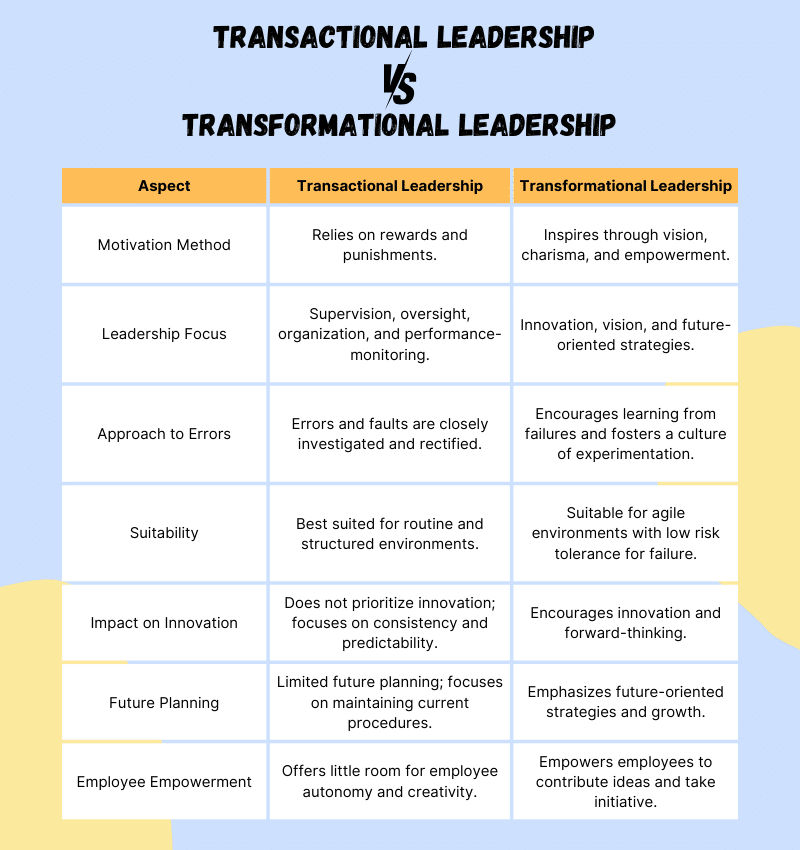
Get to know about:
What is Transformational Leadership?
The transformational leadership strategy empowers, inspires, and spurs employees to innovate and drive changes to steer the company towards future success. This is achieved by exemplifying authenticity, fostering a robust corporate culture, instilling a sense of ownership among employees, and promoting workplace autonomy at the executive level. Transformational leaders act as agents of change within the organization, adept at identifying emerging technological trends and facilitating the organization’s adaptation to these shifts.
These leaders motivate and inspire their teams without micromanagement, entrusting trained employees with decision-making authority within their designated roles. This management approach is tailored to provide employees with ample space for creativity, forward-thinking, and the discovery of innovative solutions to existing challenges. Additionally, individuals on the leadership trajectory receive mentorship and training to equip them for assuming transformational leadership roles in the future.
Theory of Transformational leadership
The genesis of transformational leadership traces back to James V. Downton in 1973, with James Burns elaborating on it in 1978. Further development came in 1985 when researcher Bernard M. Bass expanded the concept to encompass methods for evaluating its efficacy.
This paradigm advocates for leaders to exhibit genuine and robust leadership, fostering inspiration among employees to emulate.
Although Bass introduced the theory of transformational leadership in the 1970s, it remains a pertinent leadership approach utilized in contemporary settings.
Its essence, characterized by authenticity, persists regardless of changing contexts, finding relevance across diverse industries. Particularly within the dynamic tech sector, where innovation and adaptability are paramount, this leadership style proves indispensable for ensuring organizational success.
4 Components of Transformational Theory
Idealized influence: The cornerstone of effective transformational leadership lies in setting a compelling example. As a leader, your actions serve as a model for behavior across all facets of the workplace. Demonstrating authenticity in your leadership style inspires employees to uphold similar standards of performance. Rather than resorting to manipulation, the focus is on leading by example and positively influencing others through fostering trust, transparency, and respect.
Intellectual stimulation: Facilitating change entails challenging entrenched beliefs within the organization and pushing against the status quo. Encouraging innovation, creativity, critical thinking, and problem-solving is essential. Transformational leaders cultivate an environment where employees feel empowered to explore new ideas and opportunities, fostering a culture of innovation. Establishing a climate conducive to growth instills enthusiasm for initiatives such as digital transformation throughout the organization.
Inspirational motivation: As a transformational leader, it is imperative to instill a sense of connection and dedication to the organization’s vision within your team. By providing employees with a strong sense of purpose, rather than relying on fear-based motivation, you ensure their alignment with organizational goals is as profound as your own.
Individual consideration: Recognizing the uniqueness of each employee is crucial. Transformational leaders acknowledge that every individual within the organization has distinct needs, learning styles, and contributions. They tailor their coaching and mentorship approaches accordingly, supporting employees in achieving both personal and professional goals, thereby fostering a sense of ownership and autonomy in pursuit of overall business objectives.
Key Practices that Set Transformational Leaders Apart
According to Bass’ model, transformational leaders stand out by embodying a set of practices that differentiate them from other leadership styles –
These leaders foster the motivation and positive growth of their followers, inspiring them to reach higher levels of achievement and personal development.
Moreover, they serve as exemplars of moral integrity within the organization, not only adhering to ethical standards themselves but also actively encouraging others to do the same.
In addition, transformational leaders work to create an ethical work environment characterized by clear values, priorities, and standards. This environment promotes trust and integrity throughout the organization.
Furthermore, they play a crucial role in shaping the company culture by instilling a sense of collective purpose. They encourage employees to move beyond self-interest and work together towards shared goals and values.
Emphasizing authenticity, collaboration, and open communication, transformational leaders foster an environment where ideas can grow and creativity thrives.
Lastly, while offering guidance and mentorship, they empower employees to take ownership of their tasks and make decisions autonomously, thereby fostering a sense of responsibility and accountability.
Comparing Transactional and Transformational Leadership Styles

Transactional leadership relies on rewards and punishments for motivation, while transformational leadership empowers individuals through inspiration and shared vision.
Transactional leadership emphasizes meticulous oversight and consistency, while transformational leadership prioritizes innovation and adaptation to change.
Transactional leadership focuses on maintaining routine procedures and minimizing errors, while transformational leadership fosters an environment conducive to envisioning and implementing future improvements.
Transactional leadership suits environments where structure and predictability are paramount, while transformational leadership is more effective in agile environments where innovation is valued.
Transactional leadership is instrumental in establishing dependable development processes, while transformational leadership encourages individuals to generate new ideas and drive change.

Streamline your Projects Easily.
No-Code development platform for all your unique projects.






